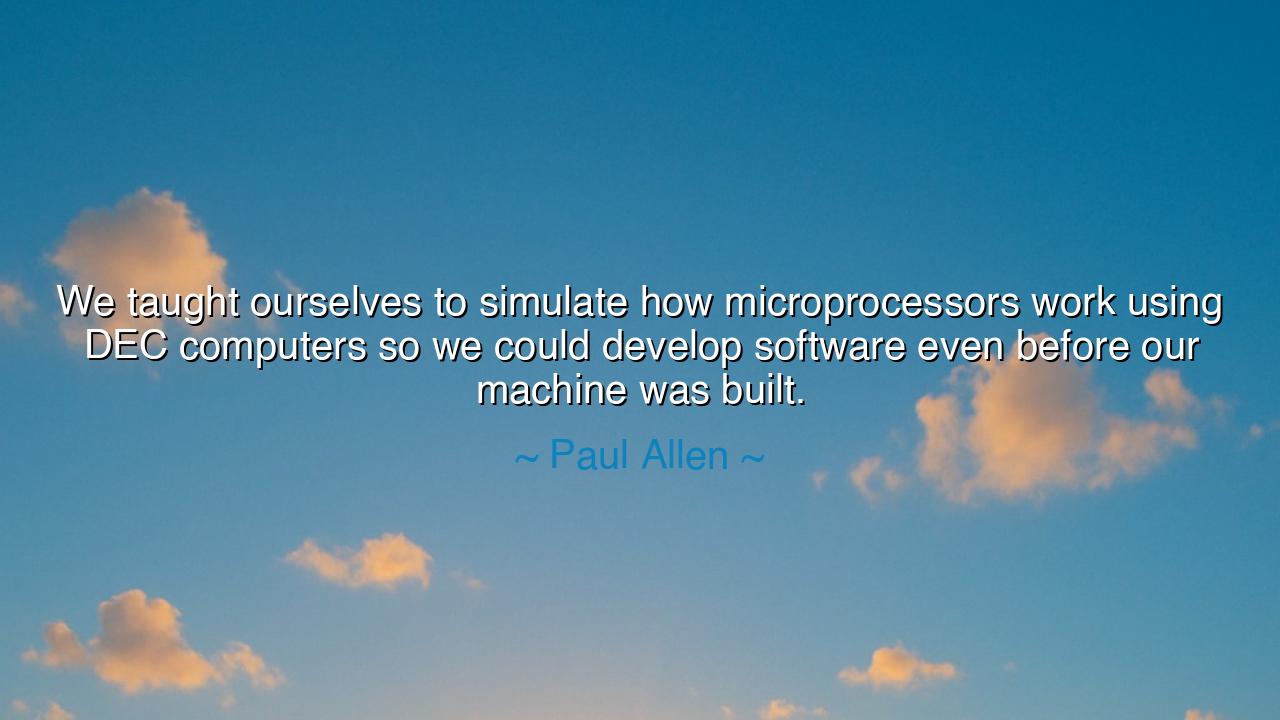
We taught ourselves to simulate how microprocessors work using
We taught ourselves to simulate how microprocessors work using DEC computers so we could develop software even before our machine was built.






“We taught ourselves to simulate how microprocessors work using DEC computers so we could develop software even before our machine was built.” – Paul Allen
In this remarkable remembrance, Paul Allen, the co-founder of Microsoft, reveals not just a moment of invention, but the very spirit that drives human progress—the power of imagination, learning, and foresight. His words carry the quiet awe of a pioneer standing at the threshold of a new age, when computers were still mysterious giants and the idea of personal computing was almost myth. When Allen says, “We taught ourselves,” he invokes one of the oldest truths known to humankind: that greatness is not bestowed—it is forged through curiosity and persistence, through the relentless hunger to understand what has not yet been built.
The origin of this quote lies in the early 1970s, when Allen and his lifelong friend Bill Gates were young dreamers fascinated by the dawning world of computers. At the time, the microprocessor was a fledgling invention—tiny, unproven, and yet brimming with the promise of a revolution. But the machine they envisioned—the personal computer—did not yet exist. There were no manuals, no teachers, no maps to guide them. So, with only their minds, and the vast, room-sized DEC computers of that era, they simulated the workings of a microprocessor, teaching themselves the unseen patterns of logic that would soon shape the digital universe.
In this act of self-education and vision, Allen reveals the essence of creation itself: to build before the thing exists. Just as the sculptor must see the statue within the marble, or the navigator must dream of the shore before the voyage begins, so too did Allen and Gates dream of software before the hardware was real. They lived in the future, using the crude tools of their time to give form to an idea that had no precedent. It was not convenience that moved them, but faith—faith that the invisible could be made visible, that the unbuilt could be brought into being through the force of intellect and imagination.
History, too, honors such visionaries. When Leonardo da Vinci sketched his flying machines in the 15th century, there were no engines, no fuel, no understanding of aerodynamics. Yet his pen traced the outlines of what would one day rule the skies. When the Wright brothers built their first glider, they tested it in their minds and on paper long before the wood and canvas took flight. Likewise, Paul Allen’s act of simulating the microprocessor was not just an experiment—it was an act of prophecy. He and his friend gazed into a void of possibility and filled it with structure and logic, laying the foundation for the world we now inhabit—a world of laptops, smartphones, and digital dreams.
In his quote, Allen speaks of the discipline of learning as sacred. “We taught ourselves,” he says—not with arrogance, but with humility. It is a reminder that knowledge is not given; it is pursued, seized, earned. There were no schools for what he sought to do, no textbooks that could teach him how to write code for a machine that did not yet exist. His generation of innovators were like the ancient alchemists, blending reason and daring in search of transformation. They proved that true mastery is born not from instruction, but from curiosity that refuses to rest.
The deeper meaning of Allen’s reflection is this: that progress belongs to those who prepare for the unseen. In life, as in invention, the greatest success often comes to those who build while others wait, who learn while others doubt. The DEC computers they used were symbols of limitation—massive, impersonal, and far removed from the intimate technology they dreamed of. Yet within those limits, they discovered freedom. They used imagination to leap across the chasm between what was and what could be. And in doing so, they ushered in a new world, where the microprocessor became the beating heart of civilization’s next chapter.
So, what lesson shall we take from Paul Allen’s words? It is this: Do not wait for the perfect tools, the right moment, or the approval of others. Begin now, with what you have. Learn relentlessly. Dream boldly. Use your imagination to simulate the world you wish to create, and let your mind walk the paths that reality has not yet built. For every great leap in human history—every invention, every art, every act of courage—was born in this same way: from those who dared to see beyond the present.
Thus, let Allen’s wisdom stand as both tribute and challenge: the future does not arrive by accident—it is crafted by hands that learn, minds that dream, and spirits that refuse to wait. The world we live in today was once only a simulation in the minds of two young men before their machine existed. So too, whatever you imagine—whatever seems impossible today—may one day stand real before the eyes of those who come after you, if you only have the courage to teach yourself what does not yet exist.






AAdministratorAdministrator
Welcome, honored guests. Please leave a comment, we will respond soon